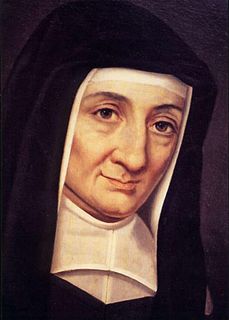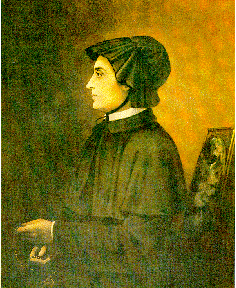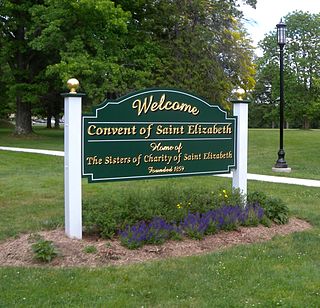
The Vincentian Sisters of Charity were an American religious congregation of Religious Sisters founded in Pittsburgh, Pennsylvania, in 1902 to serve the Slovak American immigrant population in Pennsylvania.

The Vincentian Sisters of Charity were an American religious congregation of Religious Sisters founded in Pittsburgh, Pennsylvania, in 1902 to serve the Slovak American immigrant population in Pennsylvania.
Their foundation started with the request of the Rev. Adalbert Kazincy, pastor of St. Michael Parish in Braddock, Pennsylvania, made to the Sisters of Charity of St. Vincent de Paul in Slovakia for help with caring for the children of the large Slovak immigrant population then arriving to seek work in the steel mills of Western Pennsylvania. [1]
In response to this request, a small band of pioneer Sisters emigrated to the United States from Szatmar, in the Kingdom of Hungary, under the leadership of Mother Emerentiana Handlovits, their appointed Superior. These five Sisters of Charity of St. Vincent de Paul, subsequently known as the Vincentian Sisters of Charity, were dedicated to serving God through teaching and ministering to the sick. Their primary mission was to work among the vast number of Slovak immigrants in the area. [1]
They arrived in the United States in 1902 and the Sisters immediately began teaching in the parish school, living in a rented house provided by the parish. Within two years, the parishioners of St. Michael's built them a small convent. Young local girls interested in a religious life began to inquire about entering the new congregation. In response to this interest, a novitiate was established and the first American candidate was admitted on 2 January 1905. [1]
In addition to teaching children in parochial schools, the Sisters began Vincentian High School (now Vincentian Academy) and began to serve the elderly, opening several nursing homes: the Vincentian Home, Villa de Marillac, Regency Hall Nursing Home and Adult Day Care and Marian Manor. These facilities were organized into the Vincentian Collaborative System, which began to offer a range of levels of care. [2]
The membership and work of the congregation quickly grew from teaching children in the parochial schools of southwestern Pennsylvania and the founding of Vincentian Academy to establishing hospitals, long-term healthcare facilities, and a child development center. Eventually their ministries expanded throughout the United States, including work among the impoverished African Americans in Alabama, then in Canada and later Peru. [1]
In 2001 discussions were begun by the Vincentian Sisters with the Sisters of Charity of Nazareth, founded in Kentucky in 1812, regarding the possibility of their merger into the Nazareth congregation. When asked why did the two communities merge, Sister Teresa Novak, President of Vincentian Collaborative Services, said "As Vincentian Sisters, our numbers were decreasing and the Sisters wanted to insure that the charism and mission of St. Vincent and St. Louise begun here in Western Pennsylvania in 1902 would continue." [3]
Western Province Vice-Provincial Brenda Gonzales, SCN, observed that this is one of the trends in religious life today. “It is out of necessity and a calling to be better stewards of our resources. We have finite resources and personnel. By joining together we focus on what is important – ministries and mission. By coming together we can do more.” [3]
The members of both congregations approved the merger, and on 15 November 2008, 109 Vincentian Sisters of Charity transferred their religious vows, becoming Sisters of Charity of Nazareth. [1] The Pittsburgh Sisters serve in the dioceses of Cleveland and Steubenville, Ohio; Madison, Wis.; Montgomery, Ala.; Venice, Fla.; St. Catherine, Ontario, Canada; and Greensburg and Pittsburgh, Pa. [3]

Many religious communities have the term Sisters of Charity in their name. Some Sisters of Charity communities refer to the Vincentian tradition, or in America to the tradition of Saint Elizabeth Ann Seton, but others are unrelated. The rule of Vincent de Paul for the Daughters of Charity has been adopted and adapted by at least sixty founders of religious institutes for sisters around the world.

The Sisters of Charity of Leavenworth is a Catholic religious institute based in Leavenworth, Kansas who follow in the tradition of Saints Vincent de Paul and Louise de Marillac. A member of the Sisters of Charity Federation in the Vincentian-Setonian Tradition, the order operates schools and hospitals in the United States and Peru. Members are denominated with the post-nominal letters SCL.

The Sisters of St. Joseph, also known as the Congregation of the Sisters of St. Joseph and abbreviated C.S.J. or S.S.J., is a Roman Catholic religious congregation of women founded in Le Puy-en-Velay, France, in 1650. This Congregation, named for Saint Joseph, has approximately 14,000 members worldwide: about 7,000 in the United States; 2,000 in France; and are active in 50 other countries.

The Company of the Daughters of Charity of Saint Vincent de Paul, called in English the Daughters of Charity or Sisters of Charity of Saint Vincent De Paul, is a Society of Apostolic Life for women within the Catholic Church. Its members make annual vows throughout their life, which leaves them always free to leave, without need of ecclesiastical permission. They were founded in 1633 and state that they are devoted to serving the poor through the corporal and spiritual works of mercy.

The Congregation of the Sisters of Charity of Nazareth (SCN) is a Roman Catholic order of nuns. It was founded in 1812 near Bardstown, Kentucky, when three young women responded to Bishop John Baptist Mary David's call for assistance in ministering to the needs of the people of the area.

Catherine Spalding, in 1813, aged nineteen, was elected leader of six women forming a new religious community, the Sisters of Charity of Nazareth, at a time when no education for girls, private health care, or organized social services existed on the Kentucky frontier. On January 6, 2003, the Louisville Courier-Journal named her the one woman among sixteen "most influential people in Louisville/Jefferson County history."
The Daughters of the Cross of Liège are Religious Sisters in the Catholic Church who are members of a religious congregation founded in 1833 by the Blessed Marie Thérèse Haze, F.C. (1782–1876). The organization's original mission is focused on caring for the needs of their society through education and nursing care.

Louise de Marillac , also Louise Le Gras, was the co-founder, with Vincent de Paul, of the Daughters of Charity. She is venerated as a saint by the Roman Catholic Church.

The Sisters of Charity of Saint Vincent de Paul of New York, most often known as the Sisters of Charity of New York, is a religious congregation of sisters in the Catholic Church whose primary missions are education and nursing and who are dedicated in particular to the service of the poor. The motherhouse is located at Mt. St. Vincent in the Riverdale section of the Bronx.

The Sisters of Charity Federation in the Vincentian-Setonian Tradition is an organization of fourteen congregations of religious women in the Catholic Church who trace their lineage to Saint Elizabeth Seton, Saint Vincent de Paul, and Saint Louise de Marillac.

Vincentian Academy was a Roman Catholic college preparatory school near Pittsburgh, Pennsylvania. It is located in the Roman Catholic Diocese of Pittsburgh. In February 2020 the Sisters of Charity of Nazareth announced the school will cease operations after the 2019-2020 school year.

The Sisters of Charity of Saint Elizabeth are a Roman Catholic apostolic congregation of pontifical right, based in the Convent Station area of Morris Township, New Jersey, USA. The religious order was established in 1859 in Newark, New Jersey, following the example of Elizabeth Ann Seton's community that was founded in 1809 in Emmitsburg, Maryland.
The Third Order of Saint Francis, is a third order in the Franciscan order. The preaching of Francis of Assisi, as well as his example, exercised such an attraction on people that many married men and women wanted to join the First Order (friars) or the Second Order (nuns), but this being incompatible with their state of life, Francis found a middle way and in 1221 gave them a rule according to the Franciscan charism. Those following this rule became members of the Franciscan Third Order, sometimes called tertiaries. It includes religious congregations of men and women, known as Third Order Regulars; and fraternities of men and women, Third Order Seculars. The latter do not wear a religious habit, take vows, or live in community. However, they do gather together in community on a regular basis. "They make profession to live out the Gospel life and commit themselves to that living out the Gospel according to the example of Francis."
The Sisters of Charity of Seton Hill were founded by Sister Aloysia Lowe. In 1870, she and sisters Blanche O'Keefe, Maria Theresa O'Donnell, Maria Kavanaugh and two novices were sent to western Pennsylvania from the Sisters of Charity of Cincinnati and began their work, founding and staffing schools. The sisters later expanded their work to include healthcare.
The Sisters of Charity of Cincinnati were founded in 1852 by Mother Margaret Farrell George, by the separation of the community from the Sisters of Charity in Emmitsburg, Maryland. the motherhouse of the community is at Mount Saint Joseph, Ohio.
The Sisters of Charity of the Immaculate Conception (SCIC) were established in 1854 by Honoria Conway and her companions in Saint John, New Brunswick. They serve in Canada, Peru, and Ireland.

The Congregation of Divine Providence is a Catholic religious institute of women that was founded in 1851 in the Grand Duchy of Hesse by Wilhelm Emmanuel von Ketteler, Bishop of Mainz, together with Stephanie Fredericke Amalie de la Roche von Starkenfels (1812–1857), a French noblewoman. The congregation was formally recognized by the Holy See on 16 July 1935.
The Sisters of Charity of St. Augustine, a Roman Catholic religious congregation of women, have served health, education and social service needs in the Diocese of Cleveland, Ohio, since 1851.
Maria Kaupas, S.S.C., was an American Catholic religious sister who founded the Sisters of Saint Casimir.
Catholic sisters and nuns in the United States have played a major role in American religion, education, nursing and social work since the early 19th century. In Catholic Europe, convents were heavily endowed over the centuries, and were sponsored by the aristocracy. Religious orders were founded by entrepreneurial women who saw a need and an opportunity, and were staffed by devout women from poor families. The numbers grew exponentially from about 900 in the year 1840, to a maximum of nearly 200,000 in 1965, falling to 56,000 in 2010. The network of Catholic institutions provided high status, but low-paying lifetime careers as nuns in parochial schools, hospitals, and orphanages. They were part of an international Catholic network, with considerable movement back and forth from Britain, France, Germany and Canada.